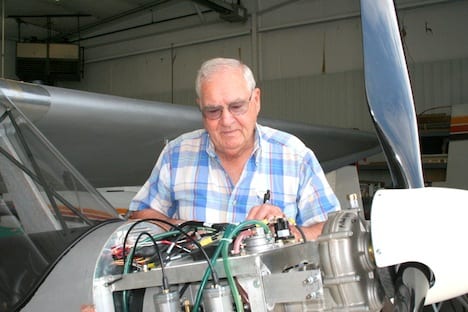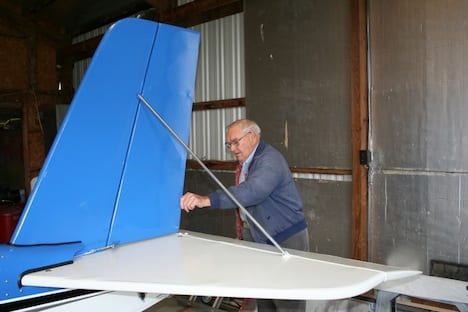By BILL WILSON
To what aviation mentor do you owe your life? Is there a person who has personally touched you, that you could say, without reservation, has taught you an essential lesson of salvation? For hundreds of pilots and amateur aircraft builders, that person is Lowell Farrand.
Lowell is somewhat of a legend in the Great Lakes states of Indiana, Ohio, Illinois, Michigan, and Wisconsin. It is there among the pilot and builder population that he is best known for his many contributions to aviation.

But look at this list and see if you might be another of his beneficiaries:
- First powered parachute flight;
- Original Experimental Aircraft Association (EAA) designee Safety Pin program with Paul Poberezny and Tony Bingelis;
- Early gyroplane pioneer and Oshkosh gyroplane winner;
- Test pilot for PDQ and TEAM aircraft ultralights;
- Test flew more than 400 homebuilt aircraft;
- Test flew one of the first helicopter rigid rotor designs, suffering an almost fatal crash due to design flaws;
- FAA Designated Airworthiness Representative for more than 500 aircraft in airplane, rotorcraft, weight shift and powered parachute categories;
- Built or restored 25 aircraft.
What is even more impressive is that this is only a partial list.
Lowell’s main impact on aviation is the lives he has saved. His vast knowledge of aircraft construction, experience with different engines and control systems, along with the perspective he has gained from so many test flights, has made him the “go to” guy for builders.
And this modest man is famously generous with his time, as all of those who have worked with him know.
“His achievements are many, but little known without much prying,” says Jerry Rea, a retired American Airlines captain. “From the 16-year-old delivery pilot of a Waco UPF-7, to the tremendously knowledgeable mechanic, to the generous Young Eagle mentor, to the ‘drop everything and I’ll be there’ friend, there is no better than Lowell Farrand.”
Sadly, Lowell’s volunteerism has often been scorned by those who commercialized the fruits of his work without rewarding him. But he continues to elicit rave reviews from builders, importers of Light-Sport Aircraft, and fellow pilots.
Lowell was a founding member of EAA Chapter 132 in Elkhart, Indiana, which is known as a “builder’s chapter.”
Chapter 132 built the first flying example of TEAM’s AeroMax AirBike with Lowell handling DAR duties. The AeroMax is an all-wood design with a two-cycle engine that can be built for under $10,000, including engine.

Southern Illinois University aviation professor Sam Pavel, the former president of Chapter 132, remembers Lowell’s deft analysis during the test flight of a chapter project aircraft: “The elevator was not trimmed correctly, but Lowell had the experience and skills necessary to safely fly the plane around the pattern using power for pitch control. It was an amazing experience watching him.”
Lowell is one of the few DARs who can license powered parachutes and gyroplanes. He regularly commutes across country to do inspections to keep up with builders’ and importers’ schedules. Manufacturers also count on him. He has inspected and provided certificates for all of the Aerotrek LSA imported by Rollison Light Sport Aircraft of Bloomfield, Indiana.
Jim Fields, CEO of Honey Bee G2 gyroplanes of Hastings, Michigan, observes: “In all of my experience with design projects for fixed and rotary wing aircraft, the one person that stands out in my mind in Lowell Farrand. He is the face of experience, passion and wisdom in the industry as a whole. We need more people just like Lowell Farrand.”

Lowell’s advice and guidance is constantly requested by builders in all seasons. He can be found in cold and windy hangars throughout the northern winter, crawling on a frigid concrete floor demonstrating the proper way to handle a fastener. He happily deals with discomfort to assure a successful later flight.
Pietenpol builder R.T. Searfoss of Syracuse, Indiana, knows that well: “With years upon years of aircraft maintenance and flying experience, he is always available when others need advice or help on a project.”
While Lowell has never taken the Aircraft & Powerplant (A&P) or Inspection Authorization (IA) exams because he has spent most of his aviation avocation in the experimental world, his knowledge is often sought by people with those credentials who do not have his breadth of experience.
It is truly hard to estimate the magnitude of the impact Lowell has had on experimental aviation, but it can surely be said that, due to his willingness to always be ready to assist when called, he has saved many an accident from happening. Those accidents, as our experimental aviation accident rate confirms, too often produce casualties.

He brings his teaching message one-on-one with the goal of providing homebuilders a friendly, dependable and valuable resource when they need it most. Best of all, he does it without hesitation or obligation.
At 82, Lowell thinks he may want to start winding down. When he elects to do so, he faces the question so many of our living legends in aviation ponder: How can you unplug from a life-long passion?
“It’s the people we will miss,” Lowell says of the deep involvement he and wife Gaylia have had in general aviation. “We’ve met some of the finest people in the world.”

There are not many people who can claim that they were the first pilot of an entirely new category of aircraft. I doubt that any of the others are with us yet today.
It is great to see that the pioneer in powered parawing flight is truly a great guy, too!
Good job, Bill!
Love your article, but you left out a really important detail, Lowell and Gay are 2 genuinely nice people.